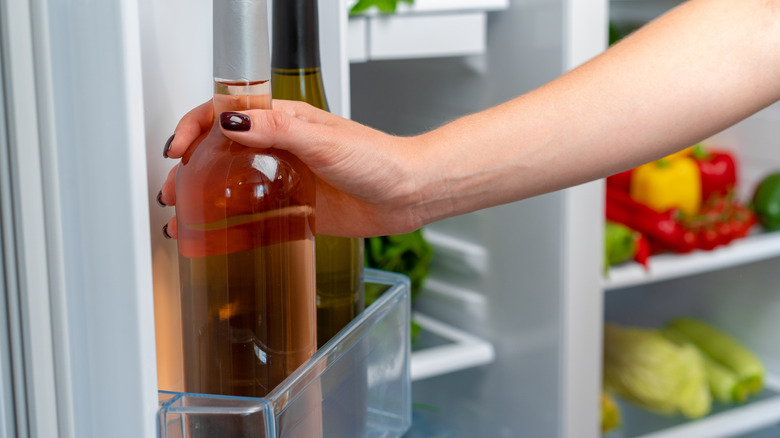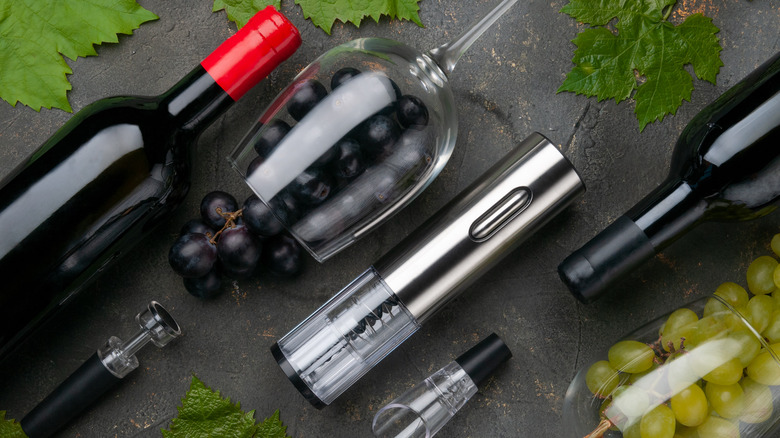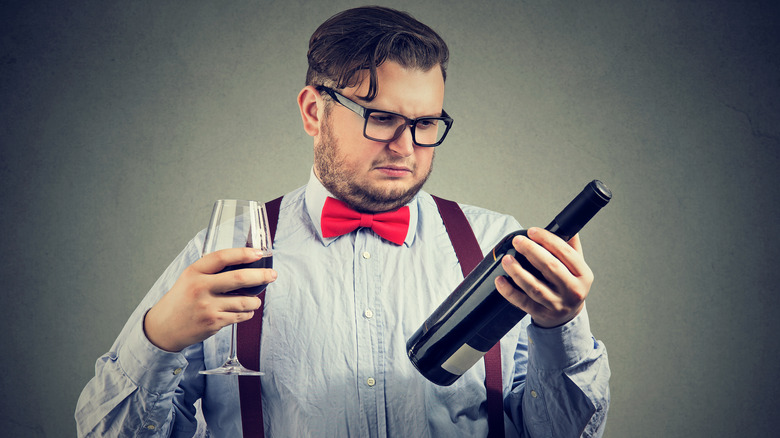Here's How Long You Can Store Open Wine In The Fridge
When cravings hit, they can hit hard, and sometimes we want nothing more than a glass of wine with our potato chips. But wanting one glass and not an entire bottle might send leftover wine down the drain, if you let it sit around. Fortunately, if you're short on a wine cellar or specialty refrigerator, you can store an open bottle in a regular fridge — while it isn't the perfect place, due to factors like the vibration of a fridge motor (which can disturb the wine), it will help your vino last longer.
How long your wine will last in the fridge greatly depends on your bottle of choice. Bubbly and sparkling wines like Champagne or prosecco are the first to go, and only last up to three days. This is because they start losing their carbonation the moment the cork is out or the lid is twisted off.
If it's longer storage times you're looking for, you should drink more rosé — pink and lighter white wines begin to lose flavor over time, but ultimately stay drinkable for up to a week. Full-bodied white wines like Chardonnay and medium reds like Merlot last for three to five days, while rich red wines like Cabernet Sauvignon remain drinkable for around four to six days. The longest-lasting wine is fortified wine, or wine with a distilled spirit added to it. These can last up to 28 days after opening when kept in a cool, dry place.
How to store your wine
The quality of wine begins to deteriorate with exposure to light, heat, and oxygen, gradually causing it to transform in flavor and color. This is why wine is often stored in cellars where little light and heat can intrude. While oxidation over time is inevitable, you can mitigate air exposure in a few ways.
The first tip is to make sure you're storing open wine in an upright position, not on its side. This will leave less liquid exposed to the air inside the bottle. If you don't mind buying one, a vacuum pump works even better to preserve an unsealed bottle by sucking out the oxygen and allowing for an airtight seal. Of course, when the cork is unavailable or unusable, a good old-fashioned wine stopper does the trick for a decent seal, too.
An upside of storing your bottle in the fridge is that it will prevent UV ray exposure and help the bottle maintain a consistent, cold temperature. The ideal temperature for wine storage is around 55 degrees Fahrenheit. While regular household refrigerators are colder than this, at around 40 degrees Fahrenheit or below, you can always allow your wine to warm up at room temperature before drinking.
How to know if your wine has gone bad
While you can potentially enjoy your wine for several days after opening, no one wants to take a sip only to learn it's oxidized and gone bad. There are signs to watch out for when deciding if the bottle has spent too much time in your refrigerator.
Firstly, give your wine a sniff. Does it smell like vinegar? If so, it's best not to drink it. A vinegar-like smell or taste in wine is a sign that it's harboring microorganisms, specifically a build-up of acetic bacteria. This is a side effect of oxidization. Be sure to inspect your drink visually, too. If it's gone bad, it likely won't be the same color as when you first poured yourself a glass. White wines can turn dark yellow, and red wine can turn to a brown shade — both of these are signs of sour wine.
Lastly, if your wine smells fine and looks fine, but doesn't taste fine, it's probably not fine. You wouldn't want to drink a bad-tasting wine anyway, so it's best to skip the leftovers entirely. With all this info in your arsenal, you can rest assured that when you have a hankering for just one glass of wine, proper storage will help it last a few days longer — and noting storage conditions can even help you avoid the worst wine at the store.


